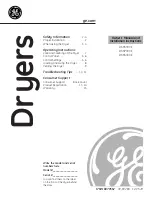
8
Carolina Cooker®
844-478-4334
Model M52509, M59541, M64556, & M64557
February 2022
3.7 Cooking Oil or Grease Fires
Cooking Oil Flash Point
Overheated cooking oil or grease will catch fire
and burn. Cooking oil or grease has a flash point
temperature ranging from 550° F to 700° F, depending on
the type of oil or grease used, altitude, and outside ambi-
ent temperature.
Note:
Overheated cooking oil will produce a huge flame.
A large cooking vat containing up to 3 gallons of cooking
oil can create a flame up to 15 feet high!
1. As cooking oil approaches its flash point
temperature, it begins to vaporize. When heated to
very high temperatures, cooking oil vapors will
self-ignite.
2. Prior to its flash point, the oil first becomes dark
and emits an unpleasant odor.
3. At about 440° F, the oil begins emitting a pale
vapor smoke.
4. At about 500° F, the smoke turns black and will
quickly turn into thick, black smoke.
5. At about 600° F, a small flame will ignite in the oil.
At this time the cooking oil has reached the point
of self-ignition and the flame will quickly grow.
3.8 LP (Propane) Gas and LP Cylinder
Safety
Failure to follow these safety instructions and warnings
could result in a fire or an explosion, which could cause
property damage, personal injury, or death.
Use Carolina Cooker® products (appliances) only
in accordance with Federal, state, and local laws
and/or ordinances. Whenever connecting, using,
storing, or transporting an LP cylinder, the tank
and its connections must be in compliance with the
following:
NFPA 54/ANSI Z223.1: National Fuel Gas Code,
NFPA 58: Liquefied Petroleum Gas Code, and
CSA B149-15: The Natural Gas and Propane Code
3.8.1 LP Cylinder Specifications
When purchasing or exchanging an LP cylinder for
this appliance, it must be constructed and marked in
accordance with the specifications for LP gas cylinders,
U.S. Department of Transportation (DOT) or the Standard
for
Cylinders, Spheres and Tubes for the Transportation
of Dangerous Goods,
CAN/CSA-B339.
WARNING
!
The cylinder must also be equipped with:
• A shut-off valve terminating in a Type 1 LP cylinder
valve outlet.
• A Type 1 valve that prevents gas flow until a positive
seal is obtained.
• A collar to protect the cylinder shut-off valve.
• An overfilling prevention device (OPD).
• The cylinder supply system must be arranged for
vapor withdrawal.
Note:
For use with 20, 30, or 40 lb. cylinders of LP gas only.
3.8.2 Transporting and Refilling an LP Cylinder
1. Never transport an LP cylinder inside a car or in
the trunk of a car. Use an open vehicle, such as a
pickup truck.
2. Allow only qualified LP gas dealers to properly fill
or repair the LP cylinder. DO NOT OVER FILL.
3. Check the dates on the cylinder collar, and if the
cylinder is past its re-qualification date, return it
for a new LP cylinder. Do not refill an out-of-date
LP cylinder.
3.8.3 Using an LP Cylinder
1. Never use the LP cylinder in a position other
than upright. Do not lay an LP cylinder on its side
during use.
2. Propane gas is heavier than air and will collect
in low areas. Proper ventilation is extremely
important.
3. When the appliance is not in use, the gas must
be turned OFF by closing the LP cylinder valve
and the gas pressure shut-off valve.
4. Before storing the appliance after use, always
disconnect the LP cylinder.
5. Never use an LP cylinder if it shows signs of
dents, gouges, bulges, fire damage, corrosion,
leakage, excessive rust, or other forms of visual
external damage. The cylinder may be hazardous
and should be checked by a qualified LP supplier.
3.8.4 Storing an LP Cylinder
1. LP cylinders must be stored outdoors, out of
reach of children, and must not be stored in
a human dwelling place, garage, or any other
enclosed area.
2. Never place a connected LP cylinder under the
appliance. Keep LP cylinder in upright position.
3. Do not store an LP cylinder within 10 feet (3m)
of any cooking appliance.
WARNING
!











































